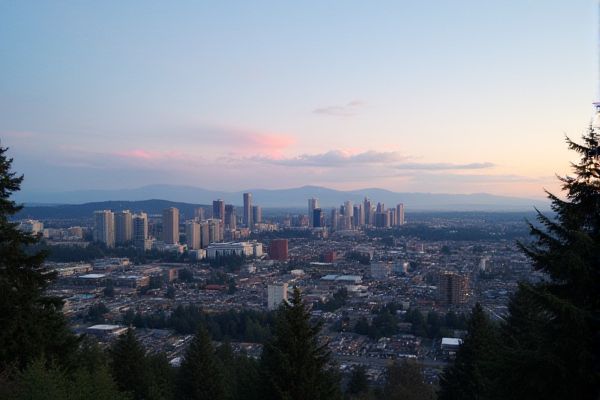
Moving to Oregon checklist: Research Oregon's climate variations. Understand Oregon's tax laws. Explore local job market opportunities. Choose a suitable neighborhood. Familiarize with local transportation options. Change your driver's license and registration. Register to vote in Oregon. Discover outdoor recreation areas. Transfer or find healthcare providers. Set up utilities and internet services.
Research Oregon's climate variations.
Researching Oregon's climate variations is essential to prepare for its diverse weather conditions, including cool and rainy winters and warm, dry summers. The state experiences significant regional differences in precipitation, which are further complicated by the impacts of climate change, such as increased temperatures, earlier snowpack melt, and more frequent extreme weather events. Oregon's climate is marked by a range from snowy volcanoes to parched deserts, with some areas receiving up to 200 inches of rain annually and others as little as five inches. To learn more about these intricate climate dynamics, visit the Oregon Encyclopedia, which offers detailed insights into how these changes are shaping the state's environment.
Understand Oregon's tax laws.
To understand Oregon's tax laws, it is essential to know that an individual is considered an Oregon resident for income tax purposes if they are domiciled in Oregon or if they maintain a permanent place of abode in Oregon and spend more than 200 days in the state, unless they can prove a temporary or transitory purpose for their stay. For more detailed information, you may refer to the guidelines provided on the Kent Anderson Law website.
Explore local job market opportunities.
To explore local job market opportunities in Oregon, research the diverse economy with strong sectors in technology, healthcare, and manufacturing. Check job boards, transfer professional licenses if necessary, and network by attending local events and joining professional organizations to find opportunities that match your skills. For a comprehensive guide, refer to this Moving to Oregon Checklist to ensure a seamless transition and understanding of what you need to embark on this new chapter confidently.
Choose a suitable neighborhood.
When choosing a suitable neighborhood in Portland, consider factors such as lifestyle, amenities, and proximity to work and schools. Neighborhoods like Downtown Portland offer a vibrant, walkable environment with access to public transportation, while areas like Southeast Portland provide a laid-back atmosphere with plenty of dining and shopping options, and Northwest Portland is known for its high-end living and proximity to Forest Park. For more detailed guidance on selecting the perfect neighborhood, visit the Portland Relo Guide for comprehensive insights.
Familiarize with local transportation options.
Exploring the transportation options in Oregon can enhance your travel experience, whether you're biking, walking, using public transit, or even telecommuting. Managed by the Oregon Department of Transportation (ODOT), these initiatives provide resources that ensure safe and efficient travel for everyone. If you're in Portland, take advantage of the public transit systems such as TriMet buses and MAX Light Rail, which can be easily navigated using the TriMet Online Trip Planner. For those seeking to explore local transit across other regions in Oregon, the Albany Transit System and Corvallis Transit System are available to cater to your public transportation needs. To delve deeper into these transit solutions and find a comprehensive overview, visit [ODOT's Transportation Options Program](https://www.oregon.gov/odot/programs/pages/to-program.aspx), which connects people to a variety of travel choices statewide.
Change your driver's license and registration.
If you've recently moved to Oregon, transferring your driver's license and vehicle registration involves a few essential steps. You'll need to fill out the Application for Driving Privileges or ID Card and provide necessary documentation like proof of legal name, U.S. legal presence, Social Security Number, and Oregon residency. Surrendering your out-of-state license and potentially passing vision and knowledge tests are also part of the process. Importantly, you must ensure that your vehicle is registered within 30 days of establishing residency. For more detailed guidance, visit the DMV Cheat Sheets website, which offers valuable resources to streamline the transition.
Register to vote in Oregon.
To register to vote in Oregon, you must be at least 16 years old, a U.S. citizen, and an Oregon resident. You can register online, by mail, or in person, and you must complete your registration at least 21 days before the election. For detailed information on how to register and the voting process, you can visit the Oregon Blue Book website, which provides comprehensive guidelines on voter registration requirements.
Discover outdoor recreation areas.
Discover a wide range of outdoor recreation areas in Oregon, including hiking and biking trails, kayaking spots, and scenic corridors such as the Corvallis-to-the-Sea Trail, Oregon's Outback, and the Wild Rivers Coast. These destinations offer activities like hiking, biking, fishing, and stargazing. Whether you're a local or a visitor, there's always something new to explore. To plan your perfect trip and get comprehensive detail about these adventures, check out the Outdoor Recreation Maps that bring these experiences to life.
Transfer or find healthcare providers.
When moving to Oregon, it is crucial to update your health coverage and find new healthcare providers. Begin by checking the provider directory on your Coordinated Care Organization (CCO) website or contact OHP Care Coordination for assistance in locating a primary care provider, dentist, or behavioral health provider within your new network. To ensure seamless healthcare access, report your move to the Marketplace or your current insurance company and adjust your health coverage as necessary. Make sure to discover new providers that are accepting new patients and within your plan's network, ensuring you maintain optimal healthcare during your relocation.
Set up utilities and internet services.
Before relocating, it's crucial to ensure that essential services such as electricity, gas, water, and internet are arranged prior to your arrival in your new home. Updating your mailing address for these services and any other subscriptions is also a necessary step. For those preparing to move, [Moving To Bend](https://movingtobend.com/relocation-blog/2024/relocation-checklist-for-moving-to-bend-oregon/) provides a comprehensive Relocation Checklist to help streamline the process. This ensures all utility providers are notified and set up in advance, making your transition as seamless as possible.
